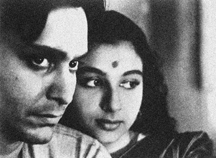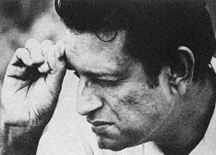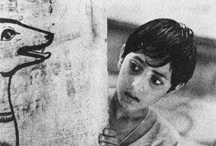 From the Village to the World: The eyes have it in director Satyajit Ray's "Apu Sansar," the third film in "The Apu Trilogy."
Indian director Satyajit Ray's classic 'Apu Trilogy' turns a single family's journey through life into a cycle of universal significance
By Richard von Busack
Many viewers, even those who considered themselves real film fans, must have wondered who that old man was, dying on camera at the 1992 Oscars. He was too weak from heart disease to sit up for a last interview, so he was filmed in his hospital bed, leaving this life with the name "Deanna Durbin" on his lips. Durbin was 20th Century-Fox's answer to Judy Garland, but who was Satyajit Ray?
India's greatest filmmaker is the deceptively simple answer, although for too many years, as the classics of world film faded away along with the art houses that screened them, Ray's fame has been muted. His Apu Trilogy regularly turns up on the list of the best films ever made, but at the time of his death, it had been 10 years or more since he'd had a United States distributor, and the original prints of his films were in bad shape. He regularly shot on Ed Wood-sized budgets, and never made what anyone would consider a lot of money in the movie business.
Did you know there is a Satyajit Ray Film and Study Collection at UC-Santa Cruz?
Fortunately, the Merchant-Ivory team has picked up The Apu Trilogy for preservation and restoration, and new 35mm prints of Pather Panchali (Song of the Little Road), 1955; Aparajito (The Unvanquished), 1956; and Apu Sansar (The World of Apu), 1960, will be screened starting this week at the Towne Theater in San Jose.
The films chart the childhood and manhood of Apu (played at various stages by Subir Bannerjee, Pinaki Sen Gupta, Smaran Ghosal and Soumitra Chatterjee), who grows up in a small village with a loving and improvident father and a mother whose various losses begin to steer her toward depression. The family moves from a rural village to Benares, the holy city on the Ganges, where Harihar, Apu's father, works as a seller of religious trinkets. After Harihar's death, Apu goes to college in Calcutta, where he stays to face the reversals any young writer can expect.
Each part of the trilogy revolves around a death and an exile--Harihar's journey to the city to work in Pather Panchali matching the death of Apu's sister from fever; Harihar's own passing in Aparajito coinciding with Apu's departure for school. Most wrenching of them all is the death of Apu's own wife in an off-camera childbirth in Apu Sansar leading to a period of wandering, mourning and renunciation, after which Apu picks up the thread of his life and the cycle starts again.
Ray's work is composed, full of silences that speak loudly. It's his exceptional quality among world filmmakers that he conveys so much about the tensions of family life, the relinquishings and smotherings. He sees much and forgives more. The surfaces of Ray's work may not be dense, but his films are.
Sometimes, even religious allegories (Apu's own spiritual crises) are handled with a lack of grand sentiment completely estranged from the cinema Ray grew up with, American or Indian. As befitting the son of India's best-known writer of nonsense verse, Ray was also fanciful, making several movies for children--probably the lingering influence of Deanna Durbin that he carried with him to that final, graceful acknowledgment of Hollywood's honorary Oscar.
As Ray did when he was financing Pather Panchali, Apu has to sell his books to support himself as a writer during the early part of Apu Sansar. It is fitting that, in the movie, a collected Dickens is one of the first to go, for Dickens should be considered a major influence on Ray.
The Apu Trilogy combines the rich discursiveness of the great English novelist with a wiser sensibility. Ray learned the characteristic embroidering of a tale that Dickens used to lighten a tragedy and to get to the root of conflicted emotions. Writing to a friend, Ray once noted (in a letter quoted in Andrew Robinson's notes for Ray's screenplay for The Chess Players):
The conventional approach tells you that the best way to tell a story is to leave out all except those elements which are directly related to the story, while the master's work clearly indicates that if your theme is strong and simple, that you can include a hundred little apparently irrelevant details which instead of obscuring the theme, only help to intensify it.
Such control is strictly for a director, like Ray, who financed, wrote, directed and ultimately photographed all his own films. Under these crazed and uncertain circumstances, he left behind nearly 30 films, a body of work worthy of calling "a world."
No other filmmaker besides Ray induces us to love life while at the same time spelling out so clearly the price of such a love, both in work and in loss. Ray knew death too well to think of it as a blessing, or as God calling his loved ones home; and he knew his sweatshops too well to be convinced, as Dickens was, that all the employers needed to do was to add a little kindness to the workers to end their essential misery.
One shot in Apu Sansar shows us Apu faced with employment at exactly the job Dickens had as a child, handwriting labels for jars. A worker fixes Apu with a mute look that says everything about what it's like to toil at a grinding job for months, maybe years. Ray himself is without Dickens' optimism that change can be achieved; all he can hope is that the insufferable can be suffered somehow.
In India, your place in life is determined for you from birth and before. Yet Ray claimed that he never felt himself a member of any caste. Still, Ray was a third-generation writer and a third-generation artist. He was raised in a Westernized intellectual circle of Brahmos who were followers of Rabindranath Tagore, the Nobel laureate, musician, patriot and fighter for women's rights.
Ray studied physics and graduated from the University of Calcutta at age 19. Like Alfred Hitchcock, he became a commercial artist--durance vile. Still, such work does teach about the life of inanimate objects, what they can, under circumstances of lighting and juxtaposition, be made to speak about the people that own them.
Sent to London by his advertising firm in 1950, Ray was finally struck by movies, and saw, he claimed, 99 of them in six months. The most important of these 99 was The Bicycle Thief; Italian neorealist director Vittorio De Sica's film, shot with nonprofessional actors on nonstudio locations. It convinced Ray that such films could be done in India, as the antithesis of the studio-bound, highly stylized Bollywood ("Bombay + Hollywood") musicals popular in India then as now.
On the way back from England, Ray decided to make a film from a book, Pather Panchali, which he had previously illustrated for publishing. It took five years to realize the project, for Ray was a novice director using amateur actors and a cameraman who had previously done only still photography.
One moment of encouragement came from meeting the French filmmaker Jean Renoir during the making his 1951 movie about India, The River. From Renoir, Ray learned a guiding principle: "Everyone has their reasons."
Another famous director, John Huston, who was nosing around India checking sites for an early version of The Man Who Would Be King in the early '50s, saw an incomplete version of Pather Panchali and recommended it to the Museum of Modern Art in New York. Pather Panchali thus debuted in America rather than India, since Ray had finished cutting it hours before it was to be shipped to Manhattan for a screening. From that time on, Ray was a fixture in the more adventurous movie theaters of the West.
Exoticism alone might have made Ray a one-time sensation for art-film audiences, but he has endured because so many aspects of his work have aged well. Among his more notable qualities as a directors is his attitude toward women. It was Pauline Kael who once wrote that in watching Ray's films, she found it hard to believe Ray was male.
In Apu Sansar, a wife (the heartbreaking Sharmila Tagore) dutifully fans her husband as he eats. From Ray's sly handling and Tagore's minxish, barely straight face, it is easy to deduce that such a scene is a fixture of Indian movies--an instruction in wifely duty from your concerned friends in the cinema industry. Ray, however, dissolves the shot into a world-turned-upside-down image of the loving husband fanning his bride as she eats.
"Compared with the flame of wifely sorrow, whose fuel is imperishable love, fire itself is chilly cold," wrote the Indian author Bana, in the 7th century, on the nobility of suttee (widow burning). The days of suttee are for the most part extinct in India, and the baroque horrors endured by the title character in the recent Bandit Queen depict a worst-case scenario, but the sort of mistreatment the Bandit Queen endured is still a possibility in a country where women are often less than second-class citizens.
In Ray's films, however, there are warnings to use women well. Tagore is unforgettable as the ultimate victim of the pedestal in Ray's 1960 film Devi (The Goddess). She incites her father-in-law's smothered desire, which leads the old man to dream, and the dream itself leads him to claim that she's the living goddess Kali, thus destroying his son's marriage and his household. On a less epic scale, in 1963's Mahanagar (The Big City), a husband nearly ruins a good marriage by his anger at his wife, a saleswoman, who is not only working but making more money than he does.
And yet I think there is one aspect of Ray's films that have made him somewhat open to charges of being slow; it's the middle-class British in him, a certain unease with the sexual. (Though when he uses an actress like Tagore, the element of the sexual is there, since she brings it to the film. Without any overt sexuality, Devi is quite erotic at times.) Considering The Chess Players (1977), I think about how Bertolucci would have handled (and did in a similar study in The Last Emperor) the subject of the Wajid Ali Shah, the poetic, decadent king of the Muslim Indian kingdom of Oudh, whose capital, Lucknow, had the same polymorphously perverse sexual reputation of, say, San Francisco. Part of the film's hesitancy derives from Ray's uneasiness with the Wajid's life (which he describes from the point of view of two flustered British soldiers).
What interests Ray in all his films is the spectacle of intellectual debauches: the marathon chess games in The Chess Players, the ruinously expensive concerts in The Music Room (1958). One Ray scholar describes the director's personality as being like Felu, the Sherlock Holmesian hero of Ray's children's fiction, whose adventures Ray filmed twice.
As a serious chess fiend, Ray must have understood his own intellectual abstractions. As a member of the elite, he must have at one point asked himself the following question, when he put it in the mouth of a journalist character in his unproduced screenplay The Alien: "What is there new to write about village life?"
Part of making the world of Apu was finding out the question to his own satisfaction. In his native Calcutta, he was six miles, he once wrote, from traditional villages, and yet he knew nothing about them. And all of his films represented an effort to satisfy his own longing to learn about his land for himself, not to present a portrait of that land to the world.
The Apu Trilogy was made in Bengali, a language that less than a sixth of India could understand. To a country then 20 percent literate, subtitles would make no difference. Influenced by neorealism, Ray was more observer than reformer. He was in his own words "a bad propagandist."
His angriest moments (as in the 1981 Indian TV movie Deliverance about the plight of India's lowest class, the Untouchables) have, he wrote, "not the anger of an exploding bomb, but of a bow stretched and quivering." It's the liberal, the humanist, in Ray that make his films loved in the West, and at the same time dissatisfying to critics who feel that India must be remade.
To get an idea of Ray's particular genius, consider Akira Kurosawa's comment that not seeing a Ray movie "is like living in the world without seeing the sun and the moon." Japan's Kurosawa shares an artistic bond with India's Ray in that they both find themselves caught in the dilemma of being too Western for the common tastes of the East and too Eastern for the common tastes of the West.
So there is a sympathy between the two directors. Ray's case, which Kurosawa never had to experience, is the predicament of being made by default to represent an enormously populous and complex country, which has been the thrust of the criticism against him. As critic David Thomson wonders: Is Ray's, or "our" (meaning the viewers'), India the same thing as India's India?
Consider the hopelessness of defining a typical American film. What if there was only one filmmaker in the United States--a much less complex country than India--known worldwide? In The Celluloid Closet, Quentin Crisp claims that returning English visitors from America always exclaim how much like our movies our country is. But whose movies are most typical? Orson Welles'? John Ford's? Martin Scorsese's? I know there'd be some minority votes for David Lynch's.
Is there any director here whom to miss is like missing the sun and the moon? No, but for those of us who do most of our traveling in a movie theater, missing Ray is more like not knowing about the roundness of the world--not knowing how exactly like us people on the other side of the world are.
| ||||||||||||||||||||||||||||||
This page was designed and created by the Boulevards team.
Copyright © 1996 Metro Publishing and Virtual Valley, Inc.



